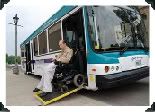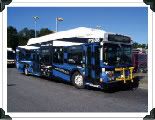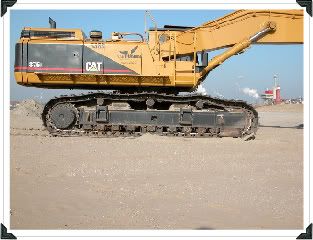 Getting Rid of Unnecessary Barriers
Getting Rid of Unnecessary Barriers
Their are probably many barriers that people simply do not think about and would not until they are faced by them. Perhaps they note them as being a nuisance if they are able bodied and grumble a bit, but they don't consider how much of a barrier they might be to someone who is not able bodied.
Disabled need not mean a person is in a wheelchair either -- it need not even be something that is long term -- except perhaps for the determination of some benefits from government bodies or insurance companies. Some things are pretty obvious: a set of stairs with no reasonable alternate route to access some facility or place; a narrow doorway or passage; an exceptionally rough patch of rocky path or walkway; and others that you can probably add to this list yourself. There are some people who do sports in wheelchairs for sure, and can nearly climb stairs in them -- they can climb simple curbs, I have seen.
 But getting on to the less obvious things.
But getting on to the less obvious things.
...like the wheelchair symbol to the right of the rather imposing doors... (image to right - image from Image*After)
I know someone who has problems getting around. She uses a mobility scooter for anything outside the apartment. The building has an elevator and the rear door exits to the parking area under the building. The parking is open on one side and there is easy, fairly open access to the lane behind the building. Luckily there is a shopping centre that is fairly well lit there so that it isn't too much like going into a scary dungeon at night and onto a dark alley.
I was surprised to hear that my friend didn't use the bus stop that is just across the street from that shopping centre. Metro Vancouver is pretty progressive and has been replacing nearly 100% of its fleet with low floor buses that can kneel.  (image to left - image from buses world news) But why did my friend travel 1 km to the next stop? At the stop close to her building she told me; there was no room between the curb and a steep drop-off into a parking lot adjacent the stop for her to manoeuvre her scooter onto the ramp into the bus! Perhaps a chair with a near zero turning radius could do the manoeuvre simply, or maybe a smaller scooter. But this my friend could not use a smaller scooter.
(image to left - image from buses world news) But why did my friend travel 1 km to the next stop? At the stop close to her building she told me; there was no room between the curb and a steep drop-off into a parking lot adjacent the stop for her to manoeuvre her scooter onto the ramp into the bus! Perhaps a chair with a near zero turning radius could do the manoeuvre simply, or maybe a smaller scooter. But this my friend could not use a smaller scooter.
When they set up the stops for Translink's buses there were no considerations for wheel chair ramps. They placed the stop well up the hill from the controlled intersection to avoid the driveways, and this placed the stop adjacent to a sharp drop-off into a parking lot. I told my friend that she should make sure to talk to the drivers about the problem and perhaps email or telephone the transit company to tell them the situation. The 1km distance might sound excessive, but it is an express bus with limited stops. I took it upon myself to write to Translink as they are open to such things and have people whose job is to listen to such problems and try find solutions.  Since then, I have heard that the solution is that the bus merely pulls up about 4 feet further along the street where there is more room for someone to manoeuvre onto the extended ramp.
Since then, I have heard that the solution is that the bus merely pulls up about 4 feet further along the street where there is more room for someone to manoeuvre onto the extended ramp.
Recently I was invited to an open house for the development of a new shopping centre. I asked -- with regards to their landscaping on the sidewalk and boulevard -- if they had taken into account such things as room for people to manoeuvre scooters and wheelchairs in and out of the buses that would be stopping outside their centre. This was important to them actually because the anchor for the shopping centre was a major pharmacy chain. They wanted to draw customers who would likely include many who would be using chairs, scooters, walkers and similar aids on the transit system.
(image of Translink bus to right from buses world news)
 With all the new construction going on, it can be difficult for any pedestrian to get around. It seems that many concessions are made for getting motor vehicle traffic through the construction zones -- but little is done for the pedestrian and great hurdles might be set into place for anyone who is not able.
With all the new construction going on, it can be difficult for any pedestrian to get around. It seems that many concessions are made for getting motor vehicle traffic through the construction zones -- but little is done for the pedestrian and great hurdles might be set into place for anyone who is not able.
This can include simple issues such as doubling the distance someone has to walk on their travels. (image to left from Image*After) This can simply be the closing of a sidewalk on one side of the road blocking it for 9 metres (30 ft approx) so that a person has to backtrack to a crosswalk cross the street, travel a block or two to the next crosswalk and then walk back. With some longish blocks and streets that are just too busy to cross at uncontrolled intersections, this can add up substantially. Such a diversion would not mean very much for a driver, but heavy metal plates might be placed over excavations so that they could be driven over. I have also seen construction debris cover half of sidewalks making them impassible except for people who are light of foot.
Many people do not realize just how impeding ice and snow (or even rain soaked leaves) can be if they do not clean their walks. A narrow swept path can still be impassible for someone in a chair or scooter. Ice and snow might be far to dangerous for someone with brittle bones even if they do walk with only a walking stick. A person with balance problems or lack of feeling in the feet can have great problems on snow. Even if the sidewalks are clear, the city and province have this nasty habit of plowing snow up against the curb making a person have to climb over it to reach the street at intersections in order to cross.
A lot of these barriers could be dealt with simply, without having to change the infrastructure much. Simply being aware and actually clearing snow, planning a bit, and remembering that some people rely on wheels... even babies in carriages -- and you don't want to force them out into traffic or to have to travel a kilometre past the closest bus stop..
Later!
~ Darrell
128.


 Stumble It!
Stumble It!

No comments:
Post a Comment